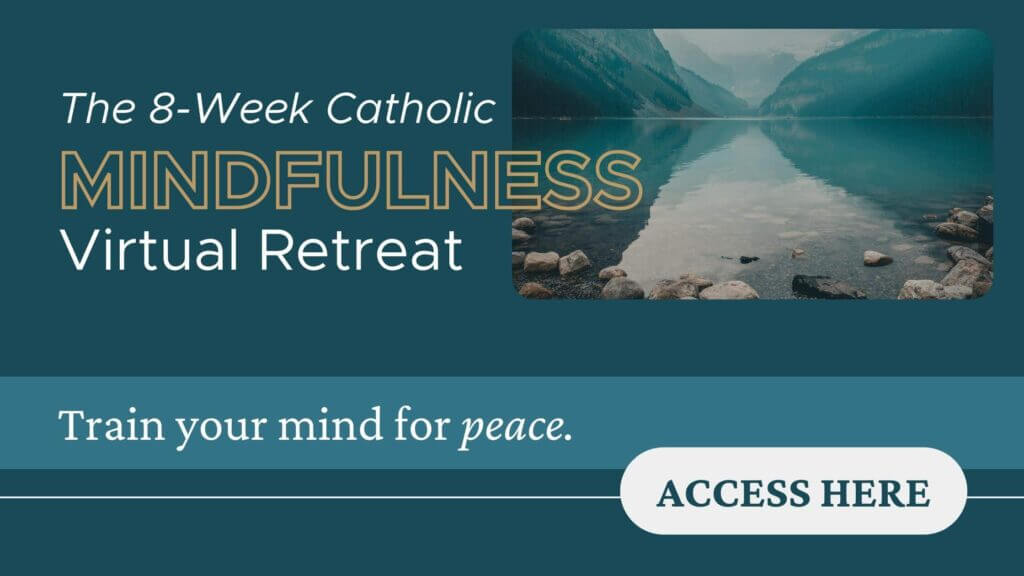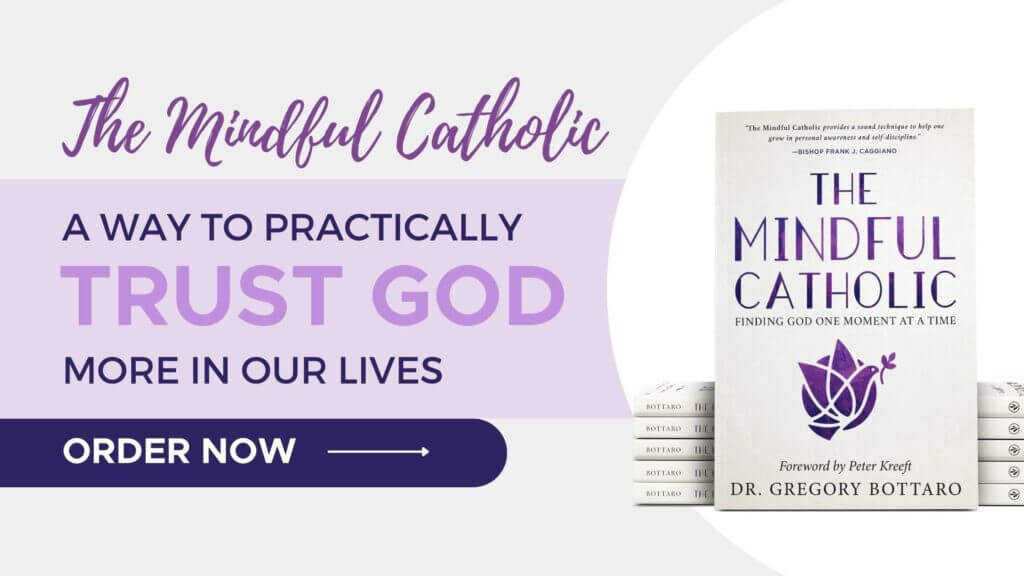
I want to offer my perspective on Catholic mindfulness, given there is a lot of misinformation surrounding this topic.
Misconception of Coffee and Mindfulness
Coffee aficionados often claim that the spread of its popularity among Catholics is due to Pope Clement VIII’s influence. He was pressed by his advisers to denounce coffee. The advisers believed coffee was the “bitter invention of Satan” because of its popularity among Muslims. However, upon tasting coffee, Pope Clement VIII declared that, “This Satan’s drink is so delicious that it would be a pity to let the infidels have exclusive use of it.”
A couple of people have asked me about a book that’s out there claiming Catholic Mindfulness to be “dangerous” to practice for Catholics and also some other blog posts and media shows. Some of these threads of thinking have been picked up by otherwise-trusted sources, such as EWTN’s Women of Grace.
I’ve gotten enough emails about this that I feel a responsibility to help clear things up for those who want clarity (and I did enjoy learning the bit about Pope Clement VIII in researching the post image).
I am especially writing this though for all those who are suffering from real mental illness, who are made to feel like their suffering doesn’t matter or it would go away if they just prayed harder or loved God more, and who don’t know whom to trust to turn to for help.
Let me first say that I assume good will on these authors’ parts and know that EWTN has brought a lot of people closer to Christ. However, there is not one ounce of legitimacy to any of their claims against Catholic Mindfulness.
Their position is actually quite un-Catholic, not only in that it is unreasonable (we believe in fides et ratio), but it’s mostly based on a heretical view of the human person that I’ve referenced in another post.
Any attempt I’ve made to dialogue has ended up going nowhere because of their visceral reaction to using the word, “mindfulness.” They react with such distaste to the use of the word that they literally won’t even bother to review the full scope of my material before they cast their judgments.
Mindfulness as a Practice and its Potential Buddhist Origins
I would like to begin with how I agree with some of the concerns that are being raised. Mindfulness can be dangerous. There is a legitimate need to help people avoid the unhealthy practice of entering a mental state of calm and relaxation while listening to exercises that prompt thoughts contrary to our Catholic worldview.
This is one of the reasons why I created Catholic Mindfulness. (I love being Catholic! I am going to spend every ounce of energy, every breath until it’s my last trying to help people know how much they are loved by God– God who is revealed to us by Jesus and his Church.)
When a person practices mindfulness, the brain turns off the “flight or fight” neural response. This means the brain feels safe (which is why it’s such a healthy practice). However, it also means that a person’s “guard is let down,” so to speak. If the guide begins to insert Buddhist ideas into the exercise, these ideas can influence the way the listener starts to conceptualize the universe. (Kind of like in the movie Inception.)

Buddhism is an atheistic worldview, in which the “self” (or God) is an illusion. When a Buddhist mindfulness teacher starts to say things like, “feel what it feels like to connect to the universe, realizing that you are the universe,” during an exercise, the listener in a vulnerable state of mind may begin to absorb those ideas.
Little by little these ideas can be disruptive to the soul because they are dissonant with Truth. This is a problem with many mindfulness exercises that are available.
These statements, however, are not part of the standard practice of Mindfulness.
Mindfulness and the Compatibility with Catholicism
Here’s what the critics are missing: The practice of mindfulness itself does not necessitate the presence of Buddhist ideas. They say that because it is a Buddhist practice, it must constitute Buddhist ideas.
The practice and the ideas are two separate things. The practice is the what – simply paying attention to the present moment. The ideas are the why – for a Buddhist because it helps our minds move away from the illusion of the self and experience unity with the universe. Some Buddhists may inject their why into their practice of Mindfulness, but that doesn’t mean Mindfulness itself has to be Buddhist.
A Buddhist may also drink tea, or write calligraphy, for the same Buddhist reason of connecting with the universe on the path to enlightenment. Non-Buddhists can also drink tea or write calligraphy – or practice mindfulness – for a non-Buddhist reason. In fact, those things can all be done for a Catholic reason! We can even drink coffee just like the Muslims do!
The difference between the what and the why explains how mindfulness can work for a Catholic. We can practice the what without the Buddhist why. We can actually then integrate the what with a Catholic why. Even if we just left it alone and practiced mindfulness as it is without any why, it would be healthy on a psychological/physiological level. By adding it to the Catholic why, we make it spiritually fruitful as well.
I want people to practice the healthy exercise of mindfulness without the unhealthy Buddhist paradigm. I wrote the Catholic Mindfulness course and book to help people understand how to stay away from the Buddhist diversions, and practice awareness of the present moment in a Catholic context.
—
Here is a breakdown of the main arguments against Catholic Mindfulness as I understand them with my responses.

Since Mindfulness is a Buddhist practice, it is dangerous for a Catholic to practice
This argument conflates something that is simply practiced by a Buddhist, with something that is Buddhist as a matter of the philosophy/religion of Buddhism. Just because the practice of mindfulness is practiced spiritually by Buddhists does not make it Buddhist spirituality in itself.
Here’s an analogy: Buddhists may drink a certain tea that has healthy effects on the body. For a Buddhist, drinking this tea may be part of a ritual with spiritual meaning. If we also would like to benefit from the physical properties of the tea, but drink it in a way that is not in conformity with the Buddhist spirituality, we would not be in error, or in danger, as Catholics.
Mindfulness is like that tea. It is a practice that Buddhists incorporate into their philosophy and spirituality, but in itself is actually a healthy practice.
As Catholics, we can learn the practice without applying the Buddhist spirituality. There is nothing intrinsic to the practice of mindfulness that is specifically Buddhist, just like there is nothing intrinsic to tea that makes it Buddhist.
But Buddhists created Mindfulness practice!
No, Buddhists didn’t create mindfulness practice (the practice of paying attention to the present moment) any more than they created tea. They happen to have been more interested in the focus of the mind, spent more time studying and understanding it, and creating ways to talk about it, but that doesn’t mean the actual faculty of paying attention to things is a Buddhist creation.
Another example is calligraphy. There is a deep connection between the art of calligraphy and the practice of Zen Buddhism. Does that mean it is wrong to enjoy the beauty of calligraphy? Should Catholics not learn the art of calligraphy? What if someone who was so in love with their Catholic faith wanted to do all things in Christ, including the art of calligraphy? Catholics could create art in a Catholic way, even an art form “discovered,” “practiced,” or “developed” by Buddhists.
Buddhists didn’t create writing, tea, or paying attention. Mindfulness is simply paying attention, and Catholics can safely and fruitfully practice the exercises that help strengthen this faculty.
Catholics already have the fullness of the truth. Since Mindfulness comes from Buddhist tradition, it can’t add anything to what we already have as Catholics and is therefore unnecessary
Again using the example of the tea: If Buddhists (or any other religion or culture) happen to be more interested in tea, and discover natural healing properties of certain teas, it actually would add to our understanding of what is good for us as humans.
The Catholic faith doesn’t claim to have the fullness of truth over everything and anything that can be known. We have the fullness of truth in regards to the revelation of Jesus Christ. Christ did not reveal to us the healing properties of tea, the etiology of pancreatic cancer, or the reasons for global warming. There are many things we as Catholics can learn from other cultures and traditions, or from science and innovation.
We should not learn about God outside of the revelation of Jesus Christ, but mindfulness is primarily about paying attention, it is not about God. Mindfulness itself is not spiritual. (Catholic Mindfulness is about God, and is totally consistent with the revelation of Jesus Christ anywhere the course actually does get into spiritual matters.)
Mindfulness is one of the steps on the eightfold path to Buddhist Enlightenment
This is true. As stated above, mindfulness was explored and implemented by Buddhists as a step towards Enlightenment, which is the state of understanding in which all division falls away as an illusion and only union with everything remains. (Which is most assuredly not consistent with Christian revelation).
Also on the eightfold path to Enlightenment (which is curiously quoted in the anti-mindfulness book), are the steps of Right Speech and Right Action. Here is what Buddhists believe about Right Speech and Right Action:
“And what is right speech? Abstaining from lying, from divisive speech, from abusive speech, and from idle chatter: This is called right speech.”
“And what is right action? Abstaining from killing, abstaining from stealing, abstaining from sexual misconduct. This is called right action.”
Notice anything interesting? How about the fact that these are pretty healthy directives to follow. Yes, even though these are Buddhist teachings, they may, in fact, be healthy!
If it is wrong to practice Mindfulness because it is on the eightfold path to Buddhist Enlightenment, then logically it must also be wrong to practice Right Speech and Right Action. No, that can’t be right. That doesn’t make sense.
We have to separate the thing that is being practiced from the reason why it is being practiced. If we don’t, we end up with the illogical conclusion that’s it’s not ok to practice Right Speech or Right Action.
It would be wrong to practice Right Speech, Right Action, or Right Mindfulness as a means to an end of obtaining Enlightenment. If that was the end you were seeking, any part of your actions or choices towards that end would be misdirected. However, just because those things can be practiced towards that end doesn’t mean they are necessarily so.
Therefore, we need to evaluate the thing in itself to decide if it is healthy or not. Even if we look at the Buddhist understanding of Right Speech or Action, those things in themselves are healthy.
Even though a Buddhist wrote the description and practices those things as a way to attain Enlightenment.
When we look at Mindfulness, even as practiced by a Buddhist, we find the same thing. Mindfulness, as described by Jon Kabat-Zinn, as studied scientifically in the program called Mindfulness-Based Stress Reduction, is simply a series of practices to learn how to focus more attention on the present moment. In itself, that is a healthy thing.
Mindfulness is not scientifically proven to work
I have no idea why this is an argument. There couldn’t be a more preposterous or absurd statement. I almost don’t want to dignify it with a response, but lately the posts/points being made are saying this very thing.
There are literally THOUSANDS of research studies that show mindfulness to be effective in reducing many different symptoms of disorders and conditions. In fact, in the book against mindfulness, the author cites about 15 different studies that show the effectiveness of mindfulness, and then she cites ONE STUDY that was supposedly against mindfulness.
Now let’s break down this one study used to supposedly debunk the therapeutic validity of mindfulness practice.
First of all, it’s a “meta-analysis.” A meta-analysis, by definition, seeks to prove an extraordinarily broad null-hypothesis or summarize a broad array of data. By the nature of the study, many variables have to be combined and it is extremely hard to make specific conclusions.
This particular meta-study is an excellent example. While the author of the book is trying to make a case against “mindfulness,” she cites a meta-analysis that reportedly found little to no positive effect of “meditation programs” in treatment for psychological issues. This study does not discriminate between mindfulness, transcendental meditation, the use of mantras, or “other methods of meditation,” including progressive muscle relaxation, focus control, and general awareness paradigms.
Such indiscretion immediately disqualifies this meta-analysis from any serious reporting of scientific data regarding the therapeutic effect of mindfulness itself.
Second of all, the study specifically states that, “Anxiety, depression, and stress/distress are different components of negative affect. When we combined each component of negative affect, we saw a small and consistent signal that any domain of negative affect is improved in mindfulness programs when compared with a nonspecific active control.
The ESs were small but significant for some of these individual outcomes and were seen across a broad range of clinical conditions. During the course of 2 to 6 months, the mindfulness meditation program ES estimates ranged from 0.22 to 0.38 for anxiety symptoms and 0.23 to 0.30 for depressive symptoms.”
For readers untrained in scientific research, these numbers may be confusing, and the language of “small… signal” when read close to each other may be confusing. However, the summary continues on to explain that, “These small effects are comparable with what would be expected from the use of an antidepressant in a primary care population but without the associated toxicities.”
There are other issues with this particular meta-analysis that make it a horrible fit for arguing against the mindfulness-based stress reduction program. This meta-analysis doesn’t discriminate between the duration of the treatment programs in review (it doesn’t matter if a program included lasts for 8 days, 8 weeks, or 8 months), and it doesn’t discriminate between training regiments (some are self-help, some are online, some are inpatient, some are outpatient, some are Partial Hospitalization, some are group formats, some are individually based, and the list goes on and on.)
Here is a recent meta-study actually on Mindfulness itself if you are interested in accurate science
Further iterations of this argument against the science of mindfulness include references to the book, The Buddha Pill, as well as an “anonymous therapist” who “felt uneasy” with the use of mindfulness and so she stopped using it.
A different study was also cited that looked at the possible misuses of mindfulness and the overuse of the concept as a panacea that cures every ailment without discretion. None of these points actually have anything to do with the clinical validity of a trained and licensed Psychologist using or teaching mindfulness in an appropriate context, which is who I am and what I do.
There are aspects to each of these concerns, however, that I would also agree with. The Buddha Pill raises excellent points about the over marketing of eastern practices as a quick fix to our western disorders. There certainly are contra-indications to using mindfulness as a treatment, as there would be for every single other treatment ever studied for any other disorder ever.
That’s the thing about being a trained and licensed Clinical Psychologist (or other medical professional). We are trained and trusted on how to understand treatments that are indicated for certain disorders and apply them appropriately, and withhold them appropriately. I purposefully keep my general material on Catholic Mindfulness light enough that anyone can practice it, and I also add in heavy caveats and warnings wherever there might be a potential complication.
As for the “anonymous therapist,” she is supposedly afraid to come forward about her counter-cultural beliefs by name for fear of the backlash she would receive from her community. I wonder what that feels like.
If you’re reading this, Anonymous Therapist, and you are actually Catholic, and actually a good therapist, I have shouldered the burden of taking the heat for unpopular viewpoints to found and run the CatholicPsych Institute for people like you to practice without fear. We also provide training for any areas where your own program may have fallen short in terms of anthropology – we don’t hold that against anyone. Email me.
Catholic Mindfulness isn’t “approved”
In one article the author presumes I am working on my own volition without regard to Church teaching or authority. She made the point that any faithful Catholic would go through the effort of obtaining a Bishop’s “Imprimatur,” which is official approval, for a Catholic work. I agree, and I have, in fact, submitted all of my work to my local Bishop for approval.
Before publishing the book, I submitted it to his office. He had his “Censor Liborum” (official title of the theologian tasked with analyzing the theology of any work that teaches on the faith and morals) thoroughly review the book. Interestingly enough, the Censor Liborum, and my Bishop in agreement with him, decided that mindfulness as such is not a spiritual practice. They validated the integration of mindfulness with Catholic spirituality, but still did not deem the integration to go far enough to warrant an official Imprimatur.
My Bishop, however, enjoyed the book and thought highly enough of it to tell me he would like his endorsement to be on the front cover. So, out of obedience, I accepted his decision that the book is not primarily one that teaches on the faith and morals, and therefore doesn’t require an Imprimatur, and I gratefully accepted his endorsement and had it printed on the front cover. I actually appreciate the validation that mindfulness is not, in fact, a teaching on faith and morals, as I’ve been saying all along.
When I explained this to the author, she just said, “well an endorsement doesn’t carry the weight of magisterial teaching.”
Yes, yes, you are absolutely right. It does not. But I happen to follow Carmelite and Franciscan spirituality, in which simple obedience matters more than obtaining the ends I seek on my own understanding. I guess that’s not everyone’s cup of tea.
You can’t use the word, “Mindfulness”

This is ultimately what I believe is their biggest issue, and all of the preceding arguments are attempts to justify this position. I would strongly agree that language matters, and the use of words matter.
This is where I will bring up another hot-button topic: Yoga. I am not making a statement here about the practice of physical exercise associated with Yoga practice, but I will say that the word, “Yoga” is actually a Sanskrit word that means “union.” In the Sanskrit system in Hindu belief, union means something essentially similar to the Buddhist meaning of union. These meanings are contrary to what we believe as Catholics in our adherence to the mystery of the Trinitarian nature of God and all created being coming from Him and reflecting Him in some way. Therefore, it would be inconsistent to use the word, “Yoga” to describe the practice of exercise that is acceptable as Catholics. (Again, I am not saying here it’s wrong to go to a Yoga class, that requires a whole different blog post). But “Catholic Yoga” would actually be a contradiction in terms. Contrast this with the use of the word, “mindfulness.” Mindfulness is, first of all, an English word. It is a translation of the Pali word “Sati,” (which is what it is called on the eightfold path).
Now, if I called my program “Catholic Sati,” I could understand the consternation. However, “mindfulness” is an English word! Not only that, but it means very simply, for every culture that practices it, paying attention. It doesn’t imply anything else the way “yoga” does in the eastern philosophies. Paying attention. Mindfully. To what’s really going on right now in this present moment instead of to the anxieties and distractions in your mind. That’s it.
We’re not supposed to seek peace
This is something I’ve seen in a post or two in more esoteric corners of the web, especially where people are attempting to blog or generalize teachings on something as intimate and sacred as the Dark Night of the Soul. Only with great trepidation and under religious obedience did the great Doctors of the Church dare to take on a task like this, but for some reason, there are people trying to do the same thing alongside posts of kittens crying like babies, memes of Homer Simpson, and everyone accusing everyone else of “fake news.”
The argument goes that the goal of mindfulness is to feel peace, which then becomes a distraction if someone is really on the path to holiness. Well, for all of the rest of us who maybe aren’t “really” on the path to holiness, I simply say in my book that, “the goal is to see with the eyes of God, to love ourselves and others as God loves us.” You can decide for yourself if you think that is a worthy pursuit in your prayer life.
To those suspicious of “peace,” understand this: When it gets so dark that your senses (or your spirit) tell you that everything is upside down, that everything is going wrong, that you are a fool and that the God you’ve given everything to doesn’t exist, there is a sense that transcends those thoughts and feelings that keeps you from going over the edge.
If you don’t want to call this sense “peace,” then don’t. There is some sense though that God does want us to have that keeps us going, no matter where we are on our spiritual journey. This is the sense that I help people cultivate in Catholic Mindfulness.
Read The Practice of the Presence of God and Abandonment to Divine Providence instead
Again, we are walking into a world of absurdity here. I literally quote in almost every chapter of my book the Practice of the Presence of God and Abandonment to Divine Providence. The course and book both include the “Novena to Abandonment to Divine Providence.” The whole basis for the integration is on these two great spiritual classics. (Along with other Carmelite writings, and other Catholic writings in general).
It is clear that there is a serious misunderstanding of the difference between the psychological and spiritual here. These antagonists wrongly define mindfulness as a spiritual practice, (in contradiction to the teaching authority of my local Bishop and his Censor Liborum, as well as any reasonable analysis,) and therefore stands in contrast to the spiritual teachings of the Catholic Church.
Instead, the fact is that mindfulness describes the psychological dimensions of the mental states that can predispose one to or accompany the spiritual dimensions of the Practice of the Presence of God or Abandonment to Divine Providence. It is not essential to living a fruitful spiritual life.
People have done so for thousands of years in the Church. However, for people of today who are scattered by mind-dumbing technology and increasing distractedness, mindfulness can be an incredibly helpful exercise.
This is how my Bishop understands it. Dr. Peter Kreeft who wrote the foreword to the book understands it this way. The Carmelite fathers who protect the Constitutions of the Discalced Carmelites in Rome understand it this way (they’re called “Definitors” and endorsed my book), along with a growing number of Discalced Carmelite monasteries, and countless priests, religious, and faithful laity who understand this. If you understand this or want to read more about what Catholic Mindfulness actually is, you can get the book here.
My prayer is that we will be able to all work together someday, to help people come to know Jesus as the Way, the Truth, and the Life!
We need to be willing to go to any corner, and length, any depth of human experience to help people move towards the Father who loves us.

If you enjoyed the guide check these other related posts:


me encanta este tema soy consagrada y el señor m,e ha llevado sin saberlo por este camino desde que lei la filocalia, por eso este tema no me asusta al contrario es necesario y urgente parta ayudar a esta humanidad perdida en la ansiedad, soy tambien medico general y me gusta la psicologia y psiquiatria he leido, pero lo mas importante es que antes de conocerlo en mi comunidad que hay vivernvia de la soledad y el silencio y meditando el señor me ha llevado por este camino
estoy tratando de descargar los audios pero solo encuemtro en ingles, y el libro del dr bottaro esta genial, he genial y muy real
gracias sigamos con esto que ayudara mucho
¡Muchas gracias por tus amables palabras y por compartir tu camino! Es hermoso escuchar cómo el Señor te ha estado guiando en este recorrido. Nos alegra compartir que estamos trabajando en las ediciones en español de los ejercicios de audio y del Retiro Virtual de Mindfulness Católico, así que ¡estate atenta!
Mientras tanto, The Mindful Catholic está disponible en español en Amazon: El católico atento.
¡Que Dios te bendiga en tu misión de ayudar a otros a encontrar paz en Él!
Habrá posibilidad de que lo traduzca al español, porque me inglés no es muy fluido. Se lo agradeceríamos mucho.
I saw a podcast with a guy called Dan Burke and one of the guys was reading the book and Dan burke basically said mindfulness is demonic. He says he has spoken to you? Also he says secular psychology shows mindfulness damages the brain and uses “cheetah house” I think to show it? Thanks!
In my experience, sati or mindfulness of breath for 2-3 hours a day has been very helpful to stop me from suicidal ideation and anxiety.
Yes, he’s been saying these things for years. He has a public story with a history of trauma in this area and I can understand why he has a certain focus on this area. He goes way too far though and it represents a really disintegrated understanding of our interior life. I’ve tried to dialogue with him but it ultimately didn’t go anywhere fruitful. What is fruitful is the practice of Catholic mindfulness, and the fruit speaks for itself.
I love coffee. I often thank God for it.
I’m looking forward to reading your book. : )
Thanks, I love coffee too! I hope you enjoy the book as much.